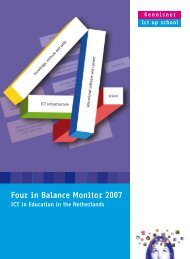Four in Balance Monitor 2011 - downloads.kennisn... - Kennisnet
Four in Balance Monitor 2011 - downloads.kennisn... - Kennisnet
Four in Balance Monitor 2011 - downloads.kennisn... - Kennisnet
You also want an ePaper? Increase the reach of your titles
YUMPU automatically turns print PDFs into web optimized ePapers that Google loves.
for example, they must be able to use the words they have learned <strong>in</strong> a<br />
language-rich context (Suhre, 2008; Corda, 2010).<br />
2 - BENEFITS oF USING ICT<br />
In short, it is precisely when ICT enables pupils to work more<br />
<strong>in</strong>dependently, that pupils <strong>in</strong> fact need the teacher’s <strong>in</strong>put more than ever.<br />
ICT does not replace the teacher but rather creates new relationships,<br />
between the pupil, the subject matter, the ICT application itself, and the<br />
teacher. It raises questions about the balance between pupils work<strong>in</strong>g<br />
<strong>in</strong>dependently, the amount of control exercised by the software, and the<br />
amount of control that the teacher has over the learn<strong>in</strong>g process.<br />
2.5 Inquiry-based learn<strong>in</strong>g<br />
Inquiry-based learn<strong>in</strong>g means teach<strong>in</strong>g methods <strong>in</strong> which pupils are more<br />
or less free to look up the answer to a question, search for <strong>in</strong>formation<br />
about a topic, study a concept, or develop skills. The problems they are<br />
told to <strong>in</strong>vestigate are often complex ones that can be answered <strong>in</strong> several<br />
ways. The process – that is, how the pupil arrives at the solution – is one<br />
of the learn<strong>in</strong>g objectives.<br />
ICT can offer considerable advantages <strong>in</strong> this respect, but as <strong>in</strong> the case<br />
of practice programs, applications that support <strong>in</strong>quiry-based learn<strong>in</strong>g<br />
require at the very least a precise, professional, and pedagogically<br />
relevant design…as well as the constant attention of the teacher.<br />
Computer simulations<br />
Computer simulations enable pupils to experiment <strong>in</strong> an environment –<br />
a model – that imitates reality. They give pupils the chance to develop<br />
practical skills, for example learn<strong>in</strong>g about dredg<strong>in</strong>g with a dredg<strong>in</strong>g<br />
simulator (oomens, <strong>2011</strong>), or to familiarize themselves with the basic<br />
pr<strong>in</strong>ciples of research, such as develop<strong>in</strong>g a hypothesis (De Jong, 2009).<br />
Games may also be classified as computer simulations. Some games are<br />
developed especially for the education sector, but pupils can even learn<br />
from store-bought games if they have a good teacher (Van rooij, 2010a;<br />
Verheul, 2009; Claessens, <strong>2011</strong>a).<br />
25








